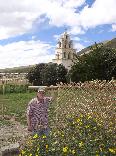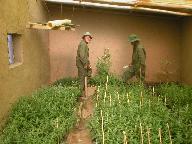|
project has been very challenging. First, there was the red tape involved in obtaining the use of the land from the local alcaldia. Then the vivero itself had to be constructed from scratch. Making an adobe structure is no easy task. The project suffered several delays because of budget shortfalls.
Now that the vivero is up and running, Max estimates it has the capacity to produce between 2000 to 5000 tree seedlings a year. The trees will be offered to local communities at no charge as long as the Consejos Municipales agree to proper conditions of planting and maintenance. Generally, the trees reduce soil erosion and provide windbreaks. The vivero is also part of the effort to return the altiplano to its original ecological state by focusing on native varieties such as Quisuara, Quenua , and Retana trees as well as compatible immigrants such as Cypress, Eucalyptus, and Pines.
Besides the vivero, Max has also been involved in pollution control. Many of the mines in the southern altiplano emit toxic drainage that contaminates water supplies. Water treatment and toxic containment are important projects.
Finally, in his remaining time, Max manages to teach a class at the Universidad Técnica de Oruro. Two days a week he makes the more than one-hour trip into Oruro to assist approximately 60 students enrolled in a geological satellite imaging course.
|
|









